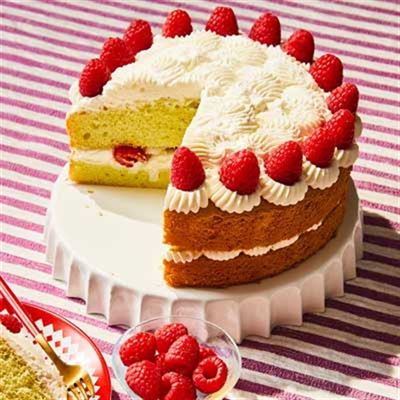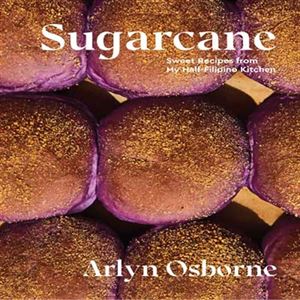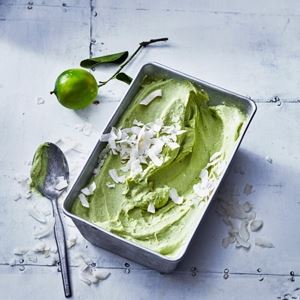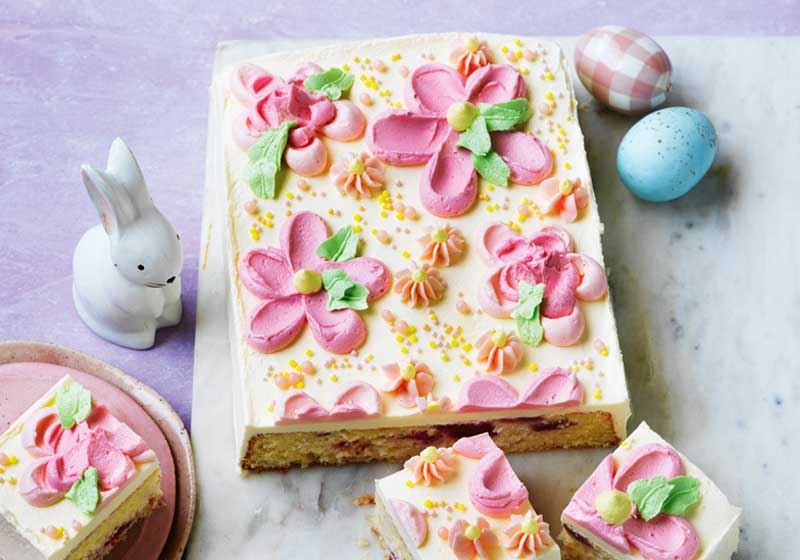Raspberry Buko Pandan Cake - Recipe by Arlyn Osborne

Ingredients
Pandan cake:
10 frozen pandan leaves, cut into small pieces
1/3 cup water
4 large eggs, separated, at room temperature
150 g granulated sugar, divided
52 g neutral oil
1/2 tsp kosher salt
110 g cake flour
1 1/2 tsp baking powder
1/4 tsp cream of tartar
Filling and garnish:
3 Tbs cold tap water
2 tsp unflavoured gelatin powder
610 g heavy cream, cold and divided
50 g granulated sugar
93 g jarred macapuno, rinsed, drained and dried well
170 g fresh raspberries
Special equipment:
20 cm chiffon cake pan with removable bottom.
Note:
The removable bottom eliminates the need for cooking spray. This allows the batter to climb (grab onto the sides) as it rises, creating a tall and lofty cake.
To use 20 cm aluminium cake pans, line the bottom with parchment paper but don’t grease the sides.
In place of frozen pandan leaves, combine 80 g water with 1/8 teaspoon green pandan paste.
Method
For the cake:
Preheat oven to 180 C.
In a small food processor, add the pandan leaves and water and purée. Scrape down the sides as needed and resist the urge to add more water. It won’t look like it’s blending well, but you just want to get the pandan really pulverised.
Place a fine-mesh sieve over a liquid measuring cup and strain the mixture, pressing with a rubber spatula to extract the green liquid (discard the solids). You should have 80 g pandan juice (if you’re short for whatever reason, add a little water). Set aside.
In a large bowl, add the egg yolks and 50 g sugar. Whisk by hand until thick and pale. Whisk in the pandan juice, oil and salt. Sift in the cake flour and baking powder and whisk until just combined.
To the bowl of a stand mixer fitted with the whisk, add the egg whites and cream of tartar. Beat on medium speed until foamy, about 1 minute. Increase the speed to medium-high and slowly add 100 g of the sugar (it takes about 1 minute to add all the sugar).
Continue beating until stiff peaks form (peaks should stand straight up and not curl at the tip), 3 to 5 minutes.
Fold the meringue into the pandan mixture in three additions.
Scrape the batter into a 20 cm aluminium chiffon cake pan with a removable bottom. Bake until the top is light golden and a toothpick inserted into the centre of the cake comes out clean, about 30 minutes.
Transfer the pan to a wire rack and let cool for 10 minutes. Run a small offset spatula around the perimeter to loosen the edges.
Using the removable bottom, separate the cake from the pan. Place the cake (right side up) on a wire rack and let cool completely.
Slice the cake in half horizontally to create two layers.
For the filling:
In a small bowl, add the water and sprinkle the gelatin evenly over top. Whisk together and let absorb for 5 minutes. Microwave until melted, 5 to 10 seconds. Whisk in 10 g of the heavy cream.
In the bowl of a stand mixer fitted with the whisk, beat the remaining 600 g of heavy cream and sugar on medium speed until it starts to thicken, about 1 minute. With the mixer on the lowest speed, gradually pour in the gelatin. Increase to medium speed and beat until fluffy but firm, about 1 minute.
To assemble:
Place the bottom cake layer (cut side up) on a cake plate. Top with 1 cup of whipped cream and spread evenly.
Transfer the remaining whipped cream to a piping bag fitted with a large star tip. Pipe dollops of the cream around the perimeter of the cake to make a border.
Scatter the macapuno in the centre of the cake, inside the piped border. Top with 70 g of the raspberries. Place the second cake layer on top (cut side down).
Using the remaining whipped cream, pipe a decorative even layer over the top of the cake. Then, pipe dollops around the perimeter to make a border. Dot the remaining raspberries around the perimeter (one berry per dollop) to create a border.









